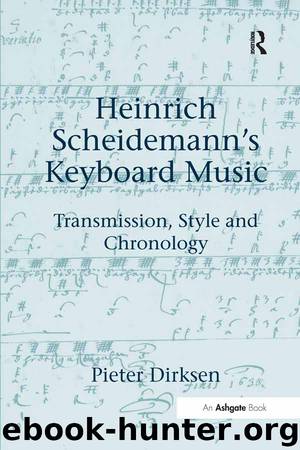Heinrich Scheidemann's Keyboard Music by Dirksen Pieter;

Author:Dirksen, Pieter;
Language: eng
Format: epub
Publisher: Routledge
Chapter 12
Intabulations
Long neglected because of a certain bias against the art of the (keyboard) intabulation in general,1 Scheidemann’s intabulations have only been published and become widespread since the 1990s. Within the context of the Sweelinck school his fourteen intabulations form a rather unexpected phenomenon.2 It is actually problematical to point to the well-known Hamburg tradition of the organ replacing the choir in motet performance as the main stimulus for Scheidemann, as is sometimes done.3 Motets in Hamburg were sung by only a single choir, the Stadtkantorei, which followed a rotating scheme through each of the four main churches. For the remaining majority of services the four organists (at the time all Sweelinck students: Heinrich Scheidemann at the Catharinenkirche, Jacob Praetorius at the Petrikirche, Johann Praetorius at the Nicolaikirche and Ulrich Cernitz at the Jacobikirche) had the responsibility of performing the prescribed de tempore motet,4 They fulfilled this task, of course, principally through improvisation. For this purpose they must usually have written out the motet, and there indeed exists a large quantity of such simple, unornamented motets in the tablatures.5 This skill, which was one of the basic ones required of an organist since the fifteenth century but which was rapidly disappearing everywhere in Europe in the course of the seventeenth century, was still required in Hamburg in 1655, as shown by Matthias Weckmann’s audition for the post of organist at the Jacobikirche in that year.6
However, since motet-playing was principally an improvisatory art, this background fails to explain the existence of so many elaborately written-out examples by Scheidemann – the more so since the tradition of writing them out had almost completely vanished by 1600 or a little later. There was simply no necessity for Scheidemann to write out his motet elaborations. That he nevertheless did so has important historical implications. Sweelinck’s keyboard programme of idiomatic, thoroughly polyphonic writing was diametrically opposed to the intabulation technique.7 He must have taught Scheidemann, who of course was raised in the strongly intabulation-oriented early Hamburg organ tradition, this consequence of his style – just as he did with the other students. It is therefore certainly no coincidence that Scheidemann’s fourteen extant intabulations apparently all stem from his maturity. There are indeed no traces of an ‘early’ stage with them (as with all the other main genres), as they are notably absent from the ‘early’ source circle (LyB, WM, Ze2).8 Furthermore, several of them bear (composition) dates, ranging from 1634 to 1656; they thus probably all stem from this period. This mature stage is clearly reflected in the wide compositional range: from the simple, transparent style of Jesu, wollst uns weisen WV 78 (based on a dance song by Giovanni Gastoldi)9 to the intricate, fantasia-like use of the organ of Dic nobis Maria, quid vidisti in via WV 51 (based on a six-part Hassler motet). Between these extremes one finds straightforward settings for one manual and pedal, ‘monodic’ intabulations for two manuals and pedal with an elaborate right-hand solo throughout, and settings for manuals only in which all voices can take part in the figuration.
Download
This site does not store any files on its server. We only index and link to content provided by other sites. Please contact the content providers to delete copyright contents if any and email us, we'll remove relevant links or contents immediately.
The Goal (Off-Campus #4) by Elle Kennedy(13605)
Kathy Andrews Collection by Kathy Andrews(11765)
Diary of a Player by Brad Paisley(7520)
What Does This Button Do? by Bruce Dickinson(6169)
Assassin’s Fate by Robin Hobb(6162)
Big Little Lies by Liane Moriarty(5745)
Altered Sensations by David Pantalony(5071)
Pale Blue Dot by Carl Sagan(4954)
Sticky Fingers by Joe Hagan(4144)
The Death of the Heart by Elizabeth Bowen(3578)
The Heroin Diaries by Nikki Sixx(3516)
Beneath These Shadows by Meghan March(3281)
Confessions of a Video Vixen by Karrine Steffans(3273)
How Music Works by David Byrne(3234)
The Help by Kathryn Stockett(3115)
Jam by Jam (epub)(3048)
Harry Potter 4 - Harry Potter and The Goblet of Fire by J.K.Rowling(3031)
Computational Linguistics and Intelligent Text Processing: 20th International Conference, CICLing 2019 La Rochelle, France, April 7â13, 2019 Revised Selected Papers, Part I by Alexander Gelbukh(2966)
Strange Fascination: David Bowie: The Definitive Story by David Buckley(2833)
